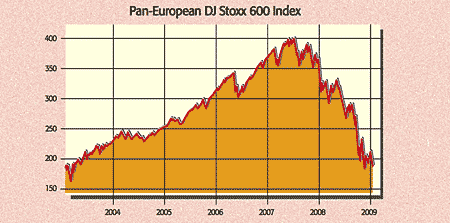
“The overall outlook is grim,” said European Commissioner Joaquin Almunia this week. Recent data show the downturn gathering pace. Industrial activity is falling off a cliff; consumer confidence is at a record low, as is activity in the services sector; and the synchronised global recession is set to lower exports by a record annual rate of 20% over the next few months, reckons Capital Economics. Barclays Capital estimates that GDP shrank by an annualised rate of 5% in the fourth quarter, as bad as in America. The European Commission now says the eurozone economy could contract by as much as 4% in 2009.
To make matters worse, there is mounting concern over the future of Europe’s single currency area. Spain this week became the second member after Greece to suffer a downgrade in its sovereign debt rating, reflecting rising public debt, as the government (which, thanks to EMU membership cannot devalue or lower interest rates to mitigate the pain from the burst housing bubble) ups spending. Greece has already suffered riots.
Banking sector jitters have resurfaced, with reports at the weekend suggesting that the 20 biggest German banks have written down just a quarter of the e300bn of toxic assets on their balance sheets, says Miles Johnson in the FT, while the Irish government has been forced to nationalise Anglo-Irish Bank. Moreover, European banks are five times more exposed to emerging markets than their US or Japanese competitors, as Stephen Jen of Morgan Stanley has pointed out. Meanwhile, over $800bn of corporate loans fall due in Europe this year, according to S&P – a further threat to European profitability as tight credit puts upward pressure on funding costs.
European profits are set to fall by at least 20% in 2009, reckon Merrill Lynch and Goldman Sachs, while Morgan Stanley thinks the peak-to-trough slide will be 43%. It’s not clear that this nasty drop has been fully factored in. Neil Dwane of Allianz thinks the market is “still too optimistic for earnings in 2009”. And investors are still reacting negatively to bad news. The fact that the cyclically adjusted p/e ratio for Europe is still in double figures and has fallen to eight in previous bad bear markets also highlights the risk of further downside. Don’t expect the next bull market to start until there are signs this mess is over – when the troughs in earnings and US house prices are in sight and banks have sorted out their balance sheets, says Morgan Stanley. It could be a very long wait.